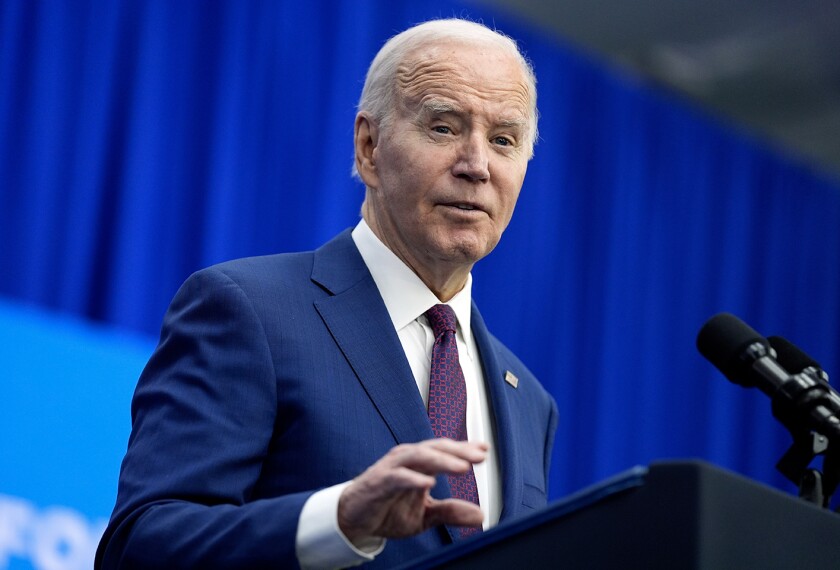When the president and Congress begin to hash out the annual budget, it’s not unlike a negotiation over a used car.
No one throws out a bottom-line number at the beginning, one low-balling it and the other shooting for the moon. The final number inevitably falls somewhere in between. So it was no surprise two weeks ago, when President Bush laid out his proposed fiscal 2003 federal budget, that his requested increase for discretionary education spending fell short of some congressional Democrats’ dreams.
But two prominent Democrats—both of whom spent the previous month in something of a political embrace with Mr. Bush—charged vehemently last week that the president’s first bid goes beyond canny dealing into the realm of bad faith.
Mr. Bush’s contemplated $1.4 billion increase in the Department of Education’s discretionary spending, a rise of about 2.8 percent over this year’s amount, constitutes “a cruel hoax on the children and parents” counting on a new federal law to improve their educational lot, said Rep. George Miller, D-Calif.
Mr. Miller, the ranking Democrat on the House Education and the Workforce Committee, was one of four committee leaders who did the bulk of the negotiations on the recent reauthorization of the Elementary and Secondary Education Act, dubbed the “No Child Left Behind” Act. Mr. Bush signed the law Jan. 8 in Ohio, flanked by Mr. Miller and his fellow ESEA architects, Sens. Edward M. Kennedy, D-Mass., and Judd Gregg, R-N.H., and Rep. John A. Boehner, R- Ohio.
“It really is a ‘left no money behind for education’ budget,” Rep. Miller said at a news conference last week, where he was joined by Sen. Kennedy, the chairman of the Senate Health, Education, Labor, and Pensions Committee.
“The president’s budget breaks the promise of education reform,” Mr. Miller said. “Passing an education bill or signing one does not make our schools better. Nor will the rhetoric. Adequate funding of the reforms will.”
The Bush administration took on the charges immediately, pointing out that Mr. Bush’s $50.3 billion spending plan for education includes $1 billion increases for both Title I, the flagship federal program for disadvantaged students, and special education state grants. Those programs alone make up about 37 percent of the Education Department’s budget.
But the proposed increases in those two programs, along with the overall education increase, means that the remaining agency programs for K-12 and higher education would be cut by $300 million under Mr. Bush’s plan.
The president’s budget would eliminate a number of programs, including $162.5 million in rural education grants first enacted in the fiscal 2002 budget that Mr. Bush likewise signed in January. And it would leave unchanged funding for several other programs, including $2.85 billion for teacher quality and $387 million to aid states in creating and administering assessments required under the new ESEA.
Tax Credit Criticized
Mr. Miller’s characterization of the Bush budget is not accurate, Education Department spokeswoman Lindsey Kozberg said.
“We’ve been very clear that the president’s budget includes the funds to implement the No Child Left Behind Act,” Ms. Kozberg said. “In some cases, that means increasing the record levels from last year’s budget, and in other cases that means sustaining them.”
Mr. Miller and Mr. Kennedy were particularly disdainful of an administration proposal to provide a tax credit of up to $2,500 a year for certain educational expenses, including private school tuition. The refundable credit—for 50 percent of expenses of up to $5,000—would go only to parents of children in schools deemed to be failing. The administration estimates that the cost to the U.S. Treasury from the tax credit would be about $3.7 billion over five years. (“Bush Proposal: Give Tax Credit for K-12 Tuition,” Feb. 13, 2002.)
Rep. Miller suggested that if the credit meets a fate similar to that of its policy cousin vouchers—which Congress jettisoned last year during ESEA negotiations—the money saved should instead be spent on federal education programs.
Asked if Mr. Bush might support such a move, Ms. Kozberg said that the administration supports giving parents educational choices and “will be vigorously pursuing the tax credit.”
Staff Writer Lisa Fine contributed to this report.




